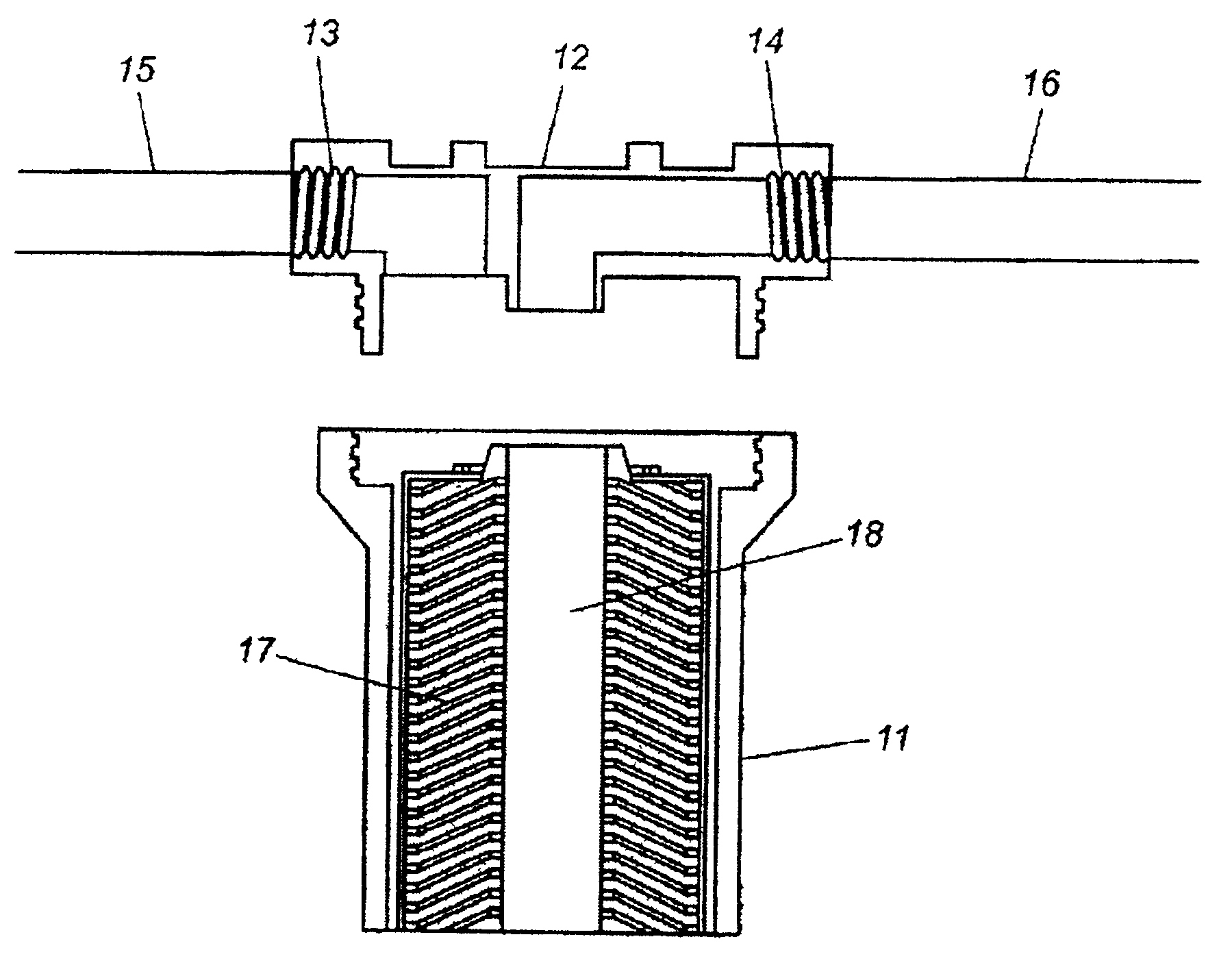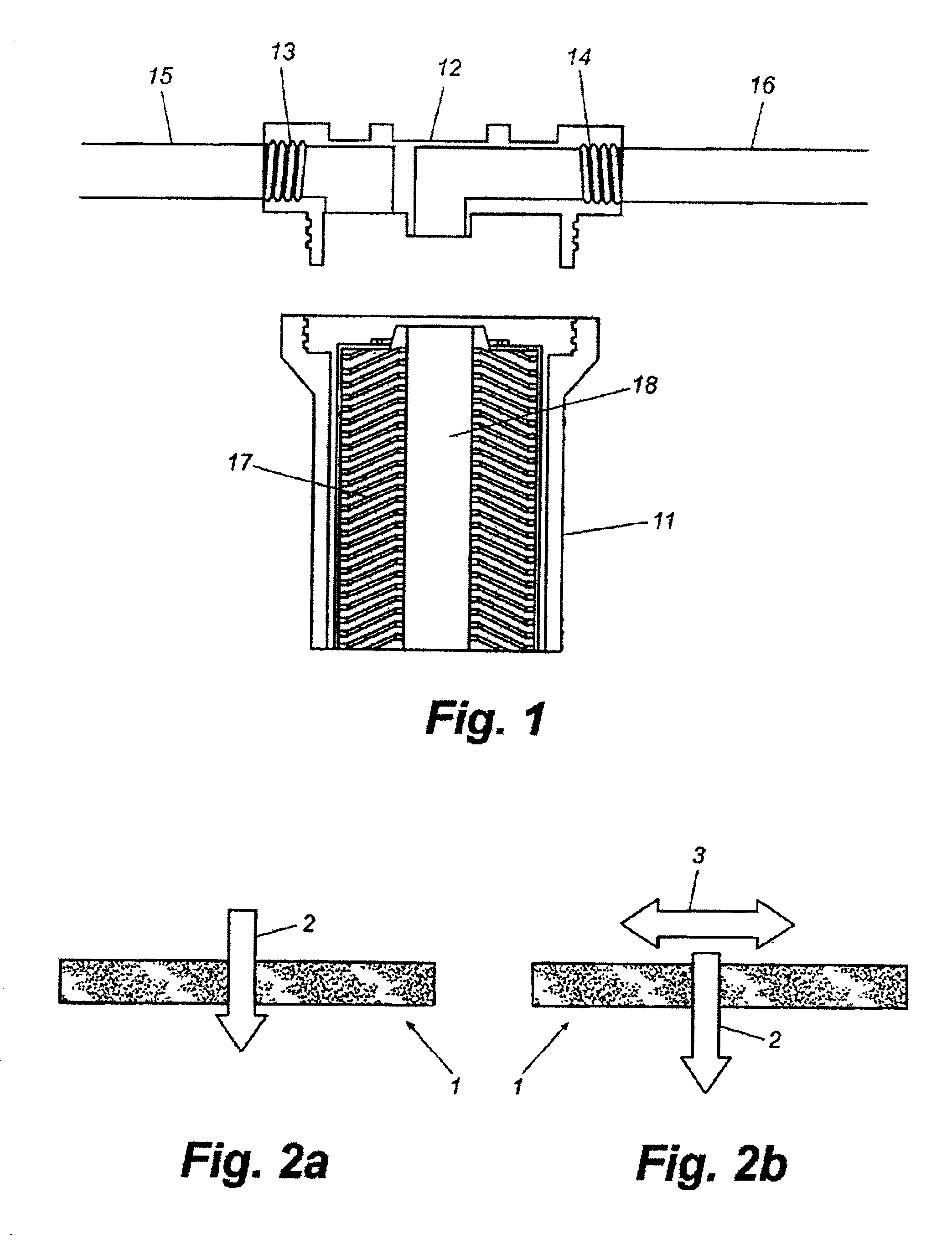Reactive compositions for fluid treatment
a technology of reactive compositions and fluid treatment, which is applied in the direction of water/sewage treatment by ion exchange, separation with moving sorbents, nuclear engineering, etc. it can solve the problems of increasing the cost of treatment, and not being easily adapted to residential settings. , to achieve the effect of easy adsorption, filtering or removal
- Summary
- Abstract
- Description
- Claims
- Application Information
AI Technical Summary
Benefits of technology
Problems solved by technology
Method used
Image
Examples
example 1
A cylindrical filter block 17 of the shape shown in FIG. 1 may be prepared with a material composition of approximately 42.5% bone charcoal obtained from Brimac Carbon Industries, approximately 42.5% GAC obtained from KX Industries, and approximately 15% thermoplastic binder material selected from one or more of the thermoplastics described above. This bone charcoal includes a mineral mixture that contains varying amounts of metal phosphates including iron, metal silicates, metal sulfates including calcium, metal carbonates including calcium, metal hydroxides, or combinations thereof.
The material may then be extruded at a temperature that provides a uniform mixture of bone charcoal, GAC, and thermoplastic binder. The cylindrical or toroidally shaped block 17 is approximately 9.8 inches in length, with an outer diameter of approximately 2.5 inches and an inner diameter (the bore 18) of approximately 1.25 inches. This shape filter fits into a standard water filtration housing used in ...
example 2
The composite prepared in Example 1 was used to oxidize a water soluble trivalent arsenic species to a water soluble pentavalent arsenic species. The following water parameters were used for testing: arsenic(III) 0.058 mg / L; calcium 40 mg / L; fluoride 1 mg / L; magnesium 12 mg / L; nitrate 2 mg / L; pH=8.5; sulfate 50 mg / L; and phosphorus 0.04 mg / L. This composite converted greater than 90% of trivalent arsenic to pentavalent arsenic. The composite maintained this function for more than 125 gallons of the test water.
example 3
A cylindrical filter block 17 of the shape shown in FIG. 1 may be prepared with a material composition of approximately 42.5% calcined bauxite obtained from CE Minerals, approximately 42.5% GAC obtained from KX Industries, and approximately 15% thermoplastic binder material selected from one or more of the thermoplastics described above. This calcined bauxite includes a mineral mixture that contains varying amounts of, silicates and metal oxides including aluminum, titanium, iron, or mixtures thereof. The material may then be extruded at a temperature that provides a uniform mixture of bone charcoal, GAC, and thermoplastic binder. The cylindrical or toroidally shaped block 17 is approximately 9.8 inches in length, with an outer diameter of approximately 2.5 inches and an inner diameter (the bore 18) of approximately 1.25 inches. This shape filter fits into a standard water filtration housing used in the home and industrial settings. The filter material has a resistance of about 300 ...
PUM
| Property | Measurement | Unit |
|---|---|---|
| melting point | aaaaa | aaaaa |
| melting point | aaaaa | aaaaa |
| concentration | aaaaa | aaaaa |
Abstract
Description
Claims
Application Information
 Login to View More
Login to View More - R&D
- Intellectual Property
- Life Sciences
- Materials
- Tech Scout
- Unparalleled Data Quality
- Higher Quality Content
- 60% Fewer Hallucinations
Browse by: Latest US Patents, China's latest patents, Technical Efficacy Thesaurus, Application Domain, Technology Topic, Popular Technical Reports.
© 2025 PatSnap. All rights reserved.Legal|Privacy policy|Modern Slavery Act Transparency Statement|Sitemap|About US| Contact US: help@patsnap.com


